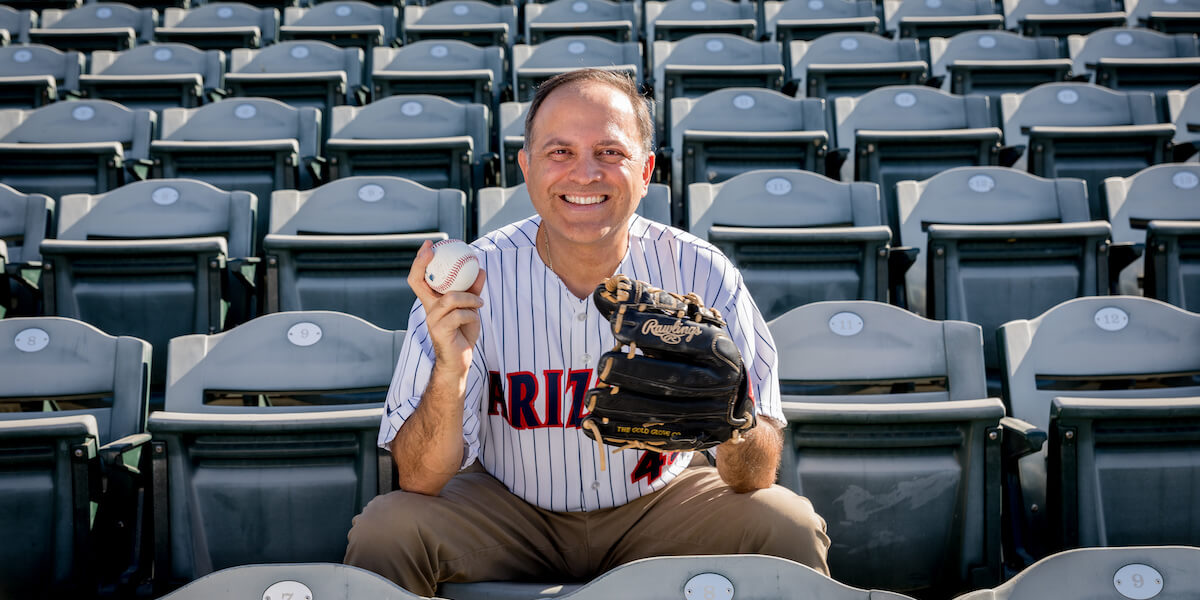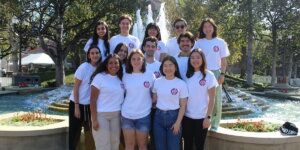
Ricardo Valerdi poses with a baseball at the Arizona Diamondbacks Stadium. (Photo/ Courtesy of Ricardo Valerdi)
“Ask a classroom of third or fourth graders: ‘Raise your hand if you like math,’” said Ricardo Valerdi, M.S. ’02, Ph.D. ’05, “and most of them would raise their hand.”
“Wait a year or two after that,” he added “and most of them would not.”
Since becoming an academic, Valerdi wanted to find ways that he could inspire young kids to develop a passion for science, technology, engineering and math, or STEM. Valerdi, who was named the University of Arizona’s Distinguished Outreach Professor in 2020, serves as a professor of systems and industrial engineering.
“In elementary school, math and STEM can be really difficult, and they don’t have the emotional tools to overcome the challenges and struggles,” explained Valerdi, who studied systems architecture and industrial and systems engineering at the USC Viterbi School.
That’s what inspired him to create the Science of Sport, a nonprofit business that uses sports to explain mathematical and scientific concepts in a way that engages young students. Since its creation, Science of Sport has fostered successful partnerships with several major sport leagues, such as the MLS, MLB, NBA and NCAA.
As Daren Heaton, the executive director of Science of Sport, noted, the organization is “helping students improve academically through sports and engaging interactive learning, or as we say it: ‘Hands on, minds on.’”
A strike of inspiration
Science and sport have long been an appealing combination for Valerdi. At USC, he had a string of influential professors who enjoyed the mechanics of sports. One of them was Stan Settles, USC Viterbi professor emeritus of industrial and systems engineering, who inspired him by building a superfast car that he raced on Utah’s Bonneville Salt Flats, zooming over 200 miles per hour.
Later, the idea for Science of Sport was born when Valerdi worked as a professor at MIT between 2005 to 2011, and he read the book “Moneyball” by Michael Lewis.
“I thought to myself, ‘wow,’ the connection between baseball and statistics is so natural. I asked myself then, ‘Why aren’t we using baseball to get kids interested in STEM?’”
From that point on, Valerdi knew he wanted to turn the intersection of sports and STEM into a business model.
Eventually, he relocated to Arizona to begin teaching at the University of Arizona. That’s when he decided he wanted to piece together a program.
Unlike robotics clubs or engineering clubs, which cater to students who want to pursue careers in STEM, Valerdi hoped Science of Sport would also interest students who struggled with mathematics and science: “Our goal is not to make everybody an engineer or mathematician,” he said. “Our goal is to get everybody to be proficient in math and science because it will be useful regardless of whatever job they have.”
Science of Sport offers a variety of services, including field trips, after-school programs, summer camps, and curriculum development. Lessons like how to measure your wingspan, the engineering of stadium design, and how to compute baseball statistics are created to teach students important mathematical and scientific skills through the approachable subject of sports.
“The reason why it has sticking power to us is because the sport makes it real,” Valerdi said. “They no longer think it’s abstract because they see the physical action taking place.”
An inclusive business model
“We’re not curriculum replacement, but curriculum enhancement,” said Heaton. The company’s goal is to work alongside educators to provide exciting interactive opportunities for students.
“We’re supporting schools and teachers and giving them the necessary resources to succeed in the classroom, like student activity books and STEM kits,” he added.
Though the kits and equipment used for these lessons are expensive, Science of Sport covers the cost through fundraising and donations.
“The ability to support teachers by giving them enough materials needed to do the lessons is how we make it equitable,” Heaton said.
Beyond the classroom, students are welcomed onto the field. Yes, that’s right — the actual sports field, where students will see these lesson plans in action with lessons like wingspan, the strike zone, fielding percentage, and much more.
“Science of Baseball is about changing your perspective,” Valerdi said, alluding to his program that partners with the Arizona Diamondbacks. “Launch angles, physics, Newton’s Laws of Motion are all really relevant topics that can now be applied to baseball.”
Powerful partnerships
The Diamondbacks were the first professional team to join with Science of Sport.
Heaton, who began his work with the company as a liaison for the Diamondbacks, knows that the partnership had to be more than a flashy title — it had to have real applications to education.
“We worked with Ricardo closely to create this program,” Heaton said. “From that success and understanding, we have been able to understand how to align the goals of each team with their specific program.”
Fortunately, it didn’t stop there for Science of Sport. Today, they have partnerships with over 50 teams across several different sports. The Los Angeles Dodgers, San Antonio Spurs, Philadelphia Phillies, New York Knicks and Memphis Grizzlies are just some of the teams that work alongside them.
Beyond team partnerships, the expanse of Science of Sport has grown dramatically. Today, 495,000 youth have been involved with Science of Sport, 5,000 teachers have been trained to teach their curriculum, 20,000 STEM kits have been handed out in classrooms and over 100 lessons and activities have been created by the Science of Sport team.
With Science of Sport already a success, Valerdi doesn’t want to stop there. In the future, he hopes to make the program even more accessible through virtual means: “We’re thinking of going digital in some ways so we can scale and go even beyond just the U.S. We’ve been developing an app to do just that.”
Published on September 1st, 2023
Last updated on September 1st, 2023











